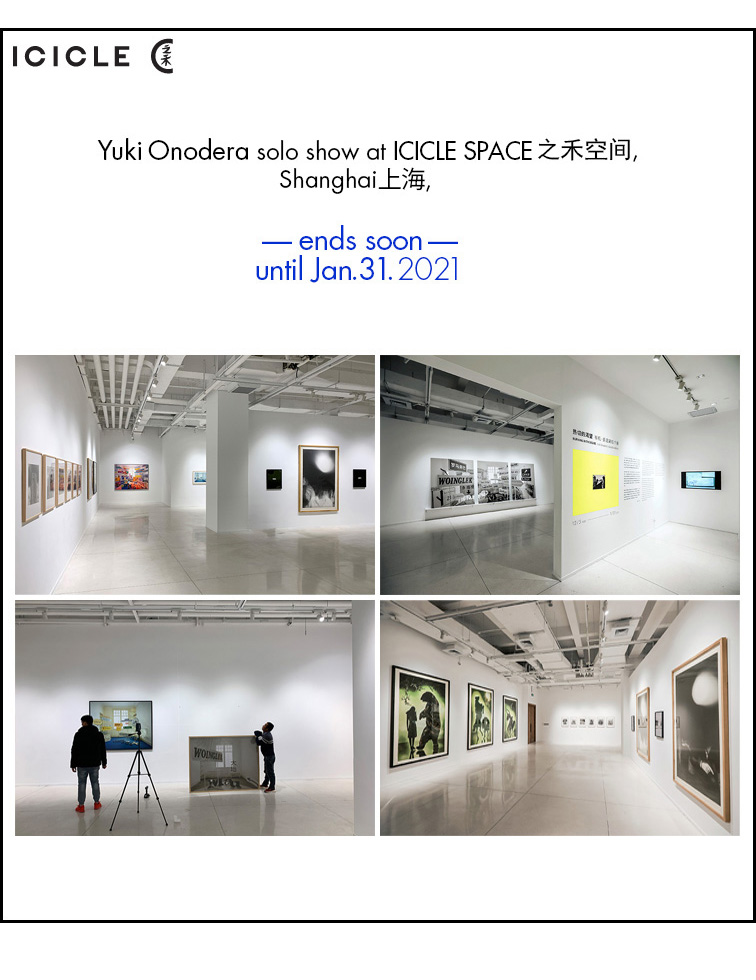Yuki Onodera
Yuki Onodera solo show at ICICLE SPACE, Shanghai, ends soon
Yuki Onodera solo show at ICICLE SPACE 之禾空间, Shanghai上海,
ends soon.
until Jan.31. 2021
https://yukionodera.fr/en/exhibitions/icicle-space-shanghai/
热切的渴望 有机·奥诺戴拉个展
"Burning with Desire" Yuki Onodera’s Solo Exhibition
策展人 Curator:林叶 Lin Ye
ICICLE SPACE 之禾空间2F 之禾画廊
上海市闵行区合川路2570号科技绿洲三期2号楼 1-2F
open:10:00-20:00
t: 021-24269598
1-2F Building 2, Shanghai Business Park, Phase 3, No. 2570 Hechuan Rd, Minghang District, Shanghai
“Burning with Desire”
In an 1828 letter to his partner, Nicéphore Niépce, Louis Daguerre wrote, “I am burning with desire to see your experiments from nature.” Here, what he longed for was photography. In the summer of 1827, Niépce shot the scenery outside the window in natural light with hand-made photographic plates which were coated with the mixture of wax and asphalt. After eight hours of exposure, he got the first photo in human history called View from the Window at Le Gras.
Although this photo is not as clear as the one taken by Daguerre in 1839, its significance lies in that the dream to copy real things by mechanical technology that a large number of scientific researchers had been fighting for in those days, seems to be possible. This photo leads human beings to a new world. From then on, their cognition of surroundings no longer depends on magic, but on imagination based on reality. The images that originally exist in camera bellows are shown to the public, serving as the carriers of information which can be spread every corner of the globe; meanwhile, their edition and extraction of the real world have fragmented our cognition, thus changing our consciousness imperceptibly and thoroughly.
It is probably the magical power of photography that makes Daguerre burn with desire. The metaphor of burning desire refers to both technology and mankind’s cognition – human’s keen desire to imagine realistically. Driven by such a desire, we, human beings, have witnessed a great leap of images, such as portraits, films, pictorials, television. Within less than two centuries, we are now surrounded by images. Our cognition also keeps changing in the world of images. Images are the important channels of communication in daily life and work, a medium to know the real world, and even to a certain extent, the virtual substitutions of real objects. Nowadays, we are more convinced that viewing images is to see the world itself, rather than to observe and learn about the world through images. Due to the blind worship of technical images, people have been gradually reduced to their slaves who copy and imitate the images during their production and dissemination. The image is no longer a medium to help human beings to understand the world, but a tool to control people.
Today, standing at the crossroads of seeking for photography, we have to reconsider its true meaning, and the relationship among photography, human beings and the world. In my point of view, Yuki Onodera’s exhibition aims to encourage people to face up to the questions mentioned above. The exhibition starts with Niépce’s View from the Window at Le Gras, which draws people back to the world of photography; and then, constructs a network with a large number of photographic works. Immersing ourselves in it, we can feel the relationship between human beings and photography, or photography and the world. If Daguerre’s desire in 1828 is to develop a technique and narrate history with images, the desire inspired by Yuki Onodera’s exhibition, in the era of image-dominated worship of technical images, might be something that requires recognition of images and reorganization of relations among human beings, photography and the world.
Curator: Lin Ye
One of the important propositions of Yuki Onodera’s artistic creation is to trace and re-examine the history of photography. In this solo exhibition, five series of her works will be displayed, namely, The World Is Not Small — 1826, How to Make a Pearl, Look out of the Window, Portrait of Second-hand Clothes, as well as Annular Eclipse. All of these have shown the relationship between image cognition and people, and the world from various angles.
————————————————————————————————————————
ICICLE SPACE 之禾空间 之禾画廊, 上海
个展, 12/5 ~ 1/31 2021
“热切的渴望”
1828年,路易·达盖尔给尼塞福尔·尼埃普斯写了一封信,信中他这样说道:“我怀着热切的渴望,想看到你用大自然做的实验。”在这里,他渴望的对象正是“摄影”。 就在一年前,1827年夏天,尼埃普斯在铅锡合金板上涂上白蜡和沥青的混合物,做成感光板,利用阳光和原始镜头,拍摄窗外的景色,经过长达八小时的曝光,获得了人类拍摄的第一张照片《窗外风景》。虽然这张照片并不像1839年公布的达盖尔摄影术拍摄的照片那样清晰细致,但是这张照片却意味着当时大量科学研究者所努力想要实现的事情,通过机械技术将现实事物如实地复制下来将成为可能。这张照片为人类打开了一扇神奇的窗口,从此以后人类对世界的认知不再依靠魔法而是 通过真实的依据进行想象。于是,原本存在于暗箱之中的影像被明室化了,成为可以在世间传播的信息载体;然而影像也开始对现实世界进行裁切、提取,让我们对现实的认知片断化,在无形中对我们的意识进行彻底的改造。
或许让达盖尔燃烧起“热切的渴望”的,正是摄影所具有的这种神奇力量。显然这 种渴望的隐喻不仅可以指向科学技术,同时也可以指向人类的认知意识——人们渴望实在地进行想象。也正是在这种“渴望”的推动下,我们迎来了影像的大发展, 肖像照、电影、画报、电视……在短短不到两百年的时间里,我们已经完全被影像所包围。我们的认知也在影像构成的拟像世界中逐渐发生变化。影像不仅是我们日常生活与工作中沟通交流的一个重要手段,认识现实世界的一个媒介,甚至在一定程度上取代了现实世界成为了一个拟真的存在,我们不再通过影像进行观看并认知世界,而是认为观看影像就是在观看世界本身。这样技术性影像的崇拜,让人逐渐沦为影像的奴隶,在影像生产与传播中不断复制并模仿影像。影像已经不再是帮助人们理解这个世界的媒介了,相反成为一种控制人的工具。
今天,我们再一次站在了寻找“摄影”的十字路口,需要重新去考察摄影究竟是什么?摄影与人的关系是什么?摄影与世界的关系又是什么?在我看来,有机·奥诺黛拉的这个展览就是要促使人们直面上述这几个问题。展览从尼埃普斯的《窗外风景》开始,将人们拉回到摄影的大门口,并通过大量的作品建构出围绕摄影展开的关系网络,让人置身其中,感受我们与摄影的关系、理解摄影与世界的关系。如果说,1828年达盖尔怀揣的是一种对技术的渴望,一种用影像叙述历史的渴望,那么有机·奥诺黛拉这个展览所激发的,可能是一种在影像一统天下,形成顽固的技术性影像崇拜的时代里,重新认知影像、重新梳理人与影像、世界与影像关系的渴望。
策 展 人
林 叶
对摄影史的追溯与再考是Yuki Onodera艺术创作的重要命题之一。在这次的个展中,带来了Yuki Onodera五个系列的作品,它们分别是:世界并不小—1826、如何制作一颗珍珠、看窗外、二手衣服肖像、日环食。这些系列从不同角度向我们展现了影像认知与人,与世界的联系。
————————————————————————————————————————
•
•
•
•
•
•
•
•
•
•
•
Design & developpement: ABC Japon
